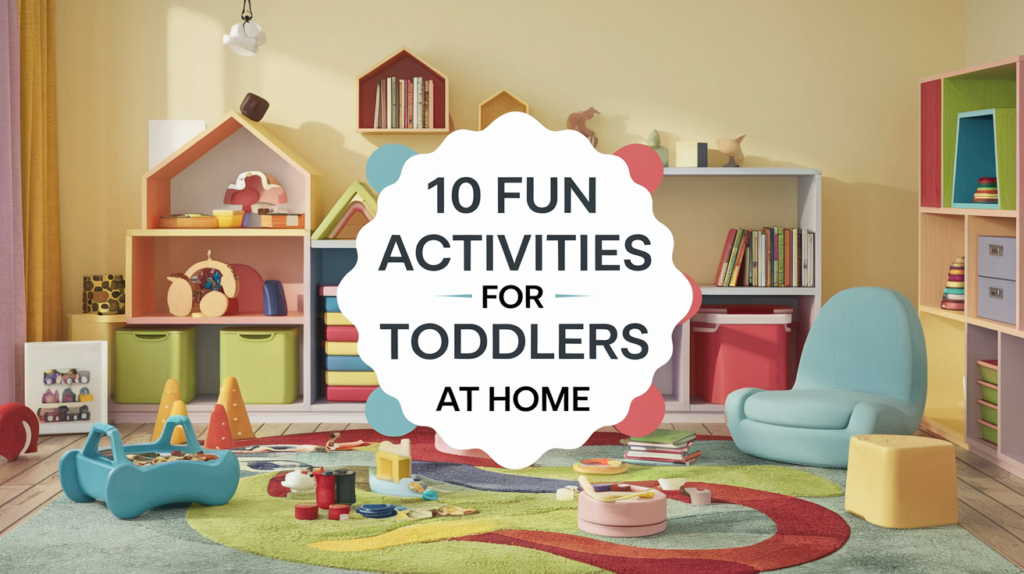What if you could create a fun and engaging environment for your toddler without breaking the bank or spending hours on setup? Engaging in fun activities for toddlers at home is crucial for their development and can be a great way to spend quality time together!
This post may contain affiliate links. If you make a purchase or booking through one of our links, we may earn a small commission. As an Amazon Associate, I earn from qualifying purchases. The content on this website was created with the help of AI.
You can try indoor toddler activities like sensory play, fine motor activities, and gross motor activities that are essential for toddlers’ cognitive and physical growth. Educational activities for toddlers can be simple and easy to implement, and they can make a big difference in their development.
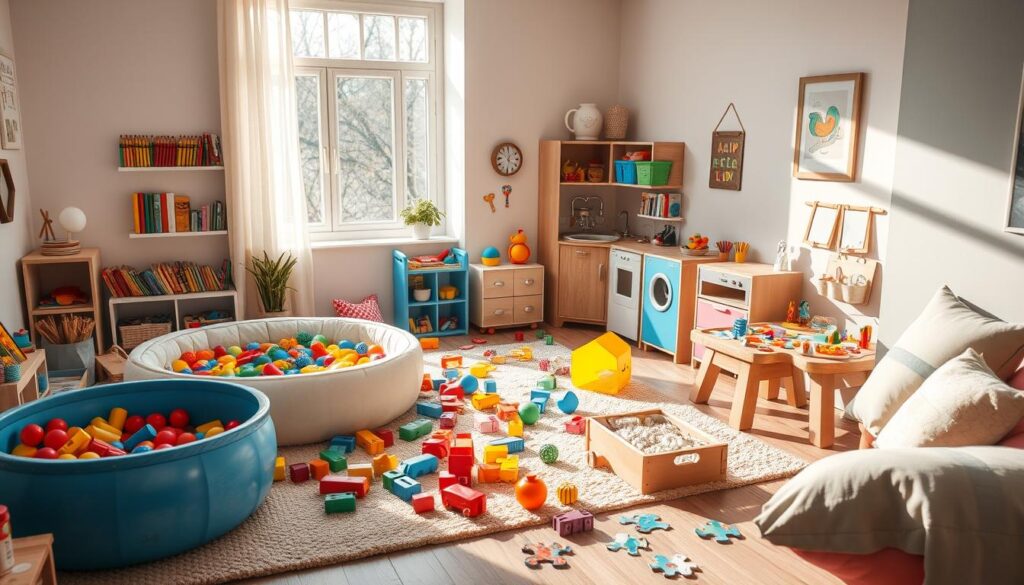
As a parent, you want to provide your child with the best possible start in life, and that includes providing them with fun and educational activities that can help them grow and develop.
Sensory play for toddlers is a great way to encourage learning and exploration, and it can be as simple as filling a bin with rice or beans and hiding small toys or other objects for your child to find.
By incorporating fun activities for toddlers into your daily routine, you can help your child develop important skills and create lasting memories.
Key Takeaways
- Engaging in fun activities for toddlers at home can help with their development and create quality time together
- Indoor toddler activities like sensory play and fine motor activities are essential for cognitive and physical growth
- Educational activities for toddlers can be simple and easy to implement, and they can make a big difference in their development
- Sensory play for toddlers can help encourage learning and exploration
- Incorporating fun activities for toddlers into your daily routine can help your child develop important skills and create lasting memories
- Minimizing distractions and leaving activities out for toddlers to revisit can help make activities more successful
- Using everyday household items can make activities more engaging and interactive
Why Indoor Activities Matter for Toddler Development
Indoor activities for toddlers play a vital role in their development, as they provide a safe and engaging environment for children to learn and grow. You can help your child develop critical skills through play, creating quality time opportunities that foster a strong bond between you and your toddler.
Research has shown that indoor activities can help combat long days and weeks during the winter, and they are essential for toddler development. Indoor activities, such as sensory play, fine motor activities, and gross motor activities, can help toddlers develop essential skills, including problem-solving, communication, and social skills.
Some examples of indoor activities that can help promote toddler development include:
- Sensory play, such as playdough or sand
- Fine motor activities, such as puzzles or coloring
- Gross motor activities, such as dancing or balloon volleyball
By incorporating these indoor activities into your toddler’s daily routine, you can help them develop critical skills and create quality time opportunities that will last a lifetime. Remember, indoor activities are not just about keeping your toddler entertained – they are an essential part of their development and growth.
| Activity | Benefits |
|---|---|
| Sensory play | Develops fine motor skills and hand-eye coordination |
| Fine motor activities | Improves problem-solving and communication skills |
| Gross motor activities | Enhances physical health and reduces stress |
Setting Up Your Home for Toddler Activities
When it comes to setting up a home for toddlers, creating a toddler-friendly environment is crucial. This involves putting away any toys and turning off the TV to minimize distractions and encourage toddlers to engage in activities. You can start by designating a specific area for play, such as a playroom or a corner of the living room, and filling it with a variety of toys and materials that promote learning and exploration.
A key aspect of setting up a home for toddlers is following safety guidelines. This includes securing any heavy furniture or appliances, covering electrical outlets, and storing hazardous materials out of reach. By taking these precautions, you can help prevent accidents and create a safe space for your toddler to play and learn.
Some ideas for setting up a toddler-friendly environment include:
- Creating a sensory play area with a clear storage container and water
- Setting up a play kitchen or play food area to encourage imaginative play
- Creating a reading nook with pillows and books to foster a love of reading
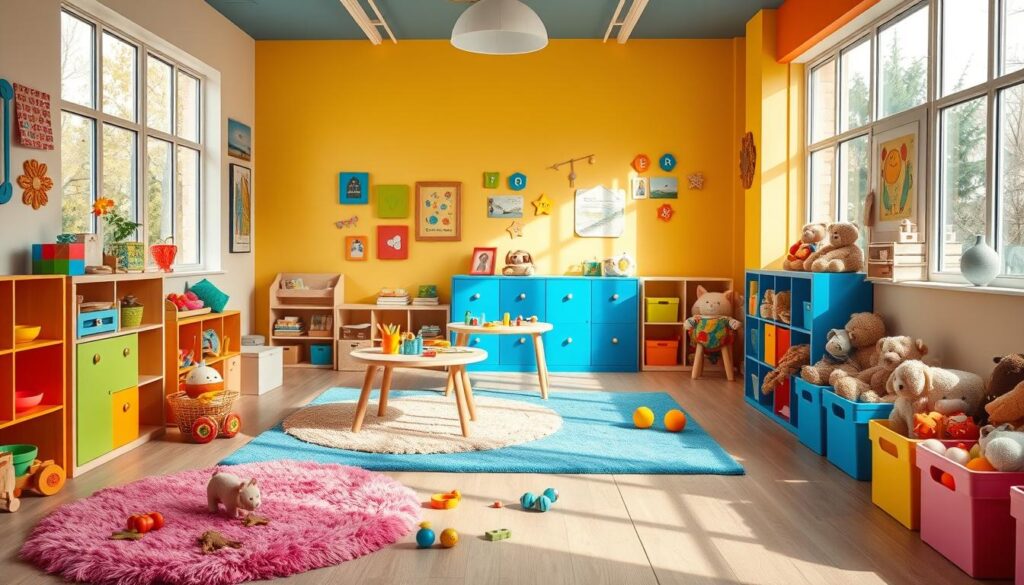
By following these tips and creating a safe and engaging environment, you can help your toddler develop important skills and have fun while doing it. Remember to always supervise your toddler during play and provide guidance and support as needed.
| Activity | Materials Needed | Benefits |
|---|---|---|
| Sensory Play | Clear storage container, water, balls | Develops vocabulary, enhances pretend play opportunities |
| Imaginative Play | Play kitchen, play food | Encourages creativity, role-playing |
Sensory Bin Adventures: A World of Touch and Feel
Engaging in sensory bin activities is an excellent way to encourage toddlers to explore their senses, particularly touch and feel. You can create a variety of sensory bins using safe materials like rice, beans, and sand, and theme-based ideas can help stimulate children’s imagination and creativity.
For example, you can create a noodle sensory bin or a water sensory bin, which can provide a fun and interactive way for toddlers to engage in sensory play. Using a clear storage container and water for sensory play can also be a great idea, as suggested by experts.
Safe Materials for Sensory Play
When it comes to sensory play, it’s essential to use safe materials that are suitable for toddlers. Some examples of safe materials include:
- Rice
- Beans
- Sand
- Water
- Play dough
Theme Ideas for Sensory Bins
Creating theme-based sensory bins can help stimulate children’s imagination and creativity. Some ideas for theme-based sensory bins include:
- Frog-themed bin
- Beach-themed bin
- Garden-themed bin
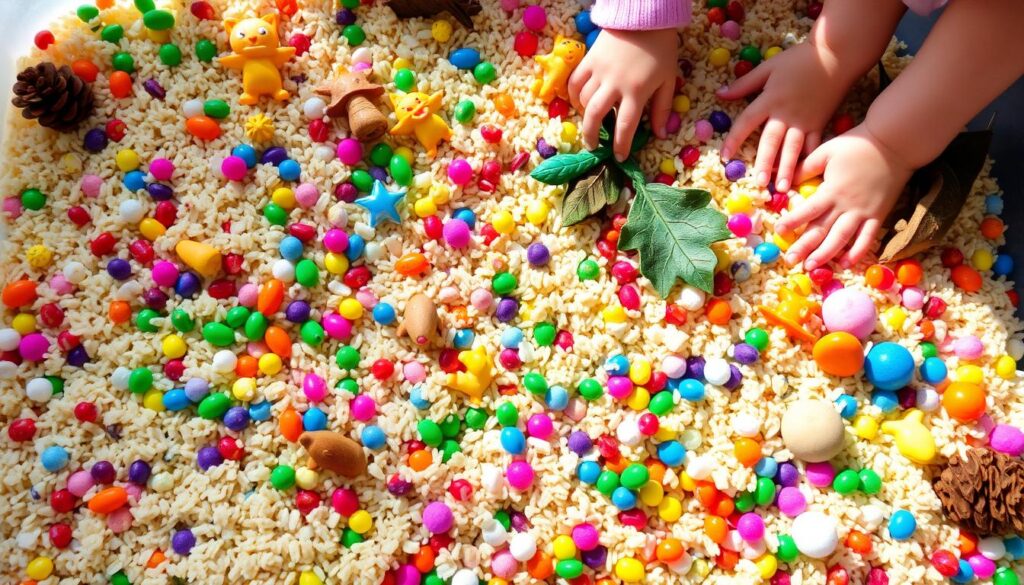
Remember to always supervise your child during sensory play and ensure their safety. With a little creativity, you can create a world of touch and feel that will engage and delight your toddler.
| Sensory Bin Theme | Materials Needed |
|---|---|
| Frog-themed bin | Green rice, small toy frogs, leaves |
| Beach-themed bin | Sand, seashells, small toy beach balls |
| Garden-themed bin | Flower-shaped erasers, small toy gardening tools, dirt |
Creative Art Projects for Little Hands
Engaging your toddler in creative art projects is an excellent way to encourage self-expression and develop their fine motor skills. You can start with simple materials like paper, markers, and crayons, and let their imagination run wild! For example, you can try painting on tin foil or using jumbo crayons to create unique and engaging art pieces.
Some fun and easy art activities for toddlers include:
- Using markers and paper to create colorful drawings
- Painting on tin foil to create shiny, metallic art
- Using jumbo crayons to draw big, bold lines
These activities not only promote fine motor skills but also foster creativity and imagination in your toddler. By providing a supportive and encouraging environment, you can help your child develop a love for art and self-expression that will last a lifetime.
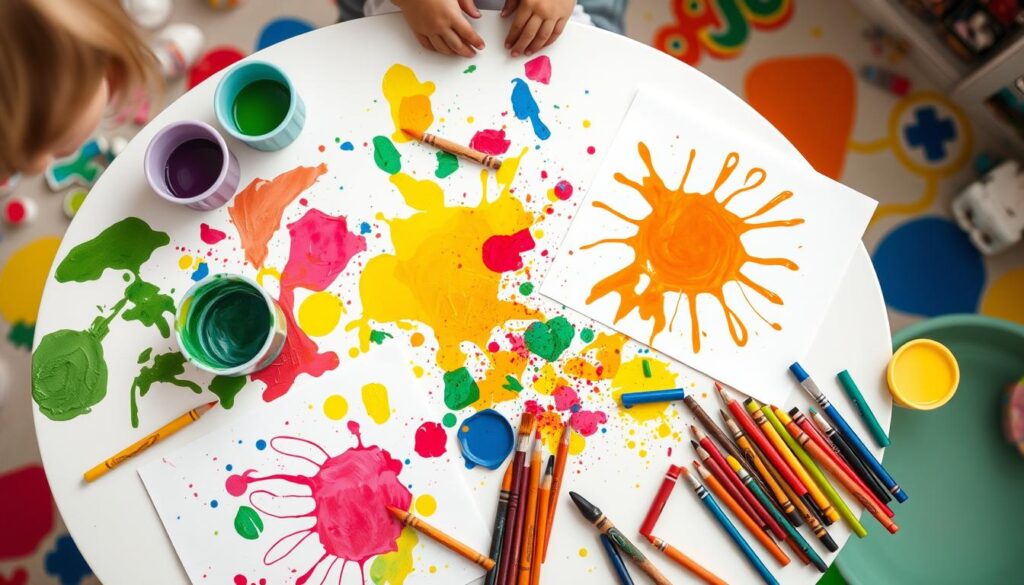
Remember, the most important thing is to have fun and be creative! Encourage your toddler to experiment with different materials and techniques, and praise their efforts and accomplishments. With a little patience and practice, your child will be creating their own unique works of art in no time.
| Art Activity | Materials Needed | Age Range |
|---|---|---|
| Painting on Tin Foil | Tin foil, paint, brushes | 2-5 years |
| Using Jumbo Crayons | Jumbo crayons, paper | 1-4 years |
| Marker Art | Markers, paper | 2-6 years |
Kitchen Science Experiments for Curious Minds
Kitchen science experiments are a great way to encourage toddlers to explore their curiosity and learn about science. Using safe kitchen chemistry, edible experiments, and learning through observation can help children develop essential skills, such as problem-solving and critical thinking.
With a few simple ingredients, you can create a variety of kitchen science experiments that are both fun and educational. For example, you can make a volcano using baking soda and vinegar, or create a lava lamp using vegetable oil, water, and food coloring.
Safe Kitchen Chemistry
When it comes to kitchen science experiments, safety is always the top priority. Make sure to use household materials that are non-toxic and easy to clean up. Some examples of safe kitchen chemistry experiments include:
- Making slime using glue, water, and borax
- Creating a homemade battery using a lemon or potato
- Making a density column using vegetable oil, water, and food coloring
Edible Experiments
Edible experiments are a great way to make toddler science fun and engaging. You can make a variety of tasty treats, such as homemade ice cream, slime-themed cookies, or fruit kebabs. These experiments can help children learn about measurement, mixing, and texture.
By incorporating kitchen science experiments into your daily routine, you can encourage your child’s curious minds to explore and learn about the world around them. So why not get started today and see the wonder and excitement on your child’s face as they discover the magic of science?
| Experiment | Materials | Learning Outcome |
|---|---|---|
| Volcano | Baking soda, vinegar, clay | Chemical reactions, geology |
| Lava Lamp | Vegetable oil, water, food coloring | Density, buoyancy |
Movement Games and Indoor Exercise
As a parent, you want to ensure your toddler is getting enough physical activity to stay healthy and happy. Movement games and indoor exercise are perfect ways to achieve this, especially on rainy days or during the winter months. You can set up a mini obstacle course using household items, like couch cushions and chairs, and have your toddler crawl, jump, and climb through it.
Another fun idea is to put on some music and have a dance party! This is a great way to get your toddler moving and grooving, while also bonding with them. You can even incorporate some simple dance moves, like spinning and twirling, to make it more engaging. For example, you can try sock skating or bubble bashing to add some excitement to your indoor exercise routine.
Here are some more ideas for movement games and indoor exercise:
- Push-ups and jumping jacks
- Headstands and balancing acts
- TikTok dances and dance parties
- Scavenger hunts and sensory bin activities
Remember to always supervise your toddler during these activities and provide a safe and supportive environment for them to explore and have fun. With a little creativity, you can turn your home into a playground and keep your toddler active and entertained all year round.
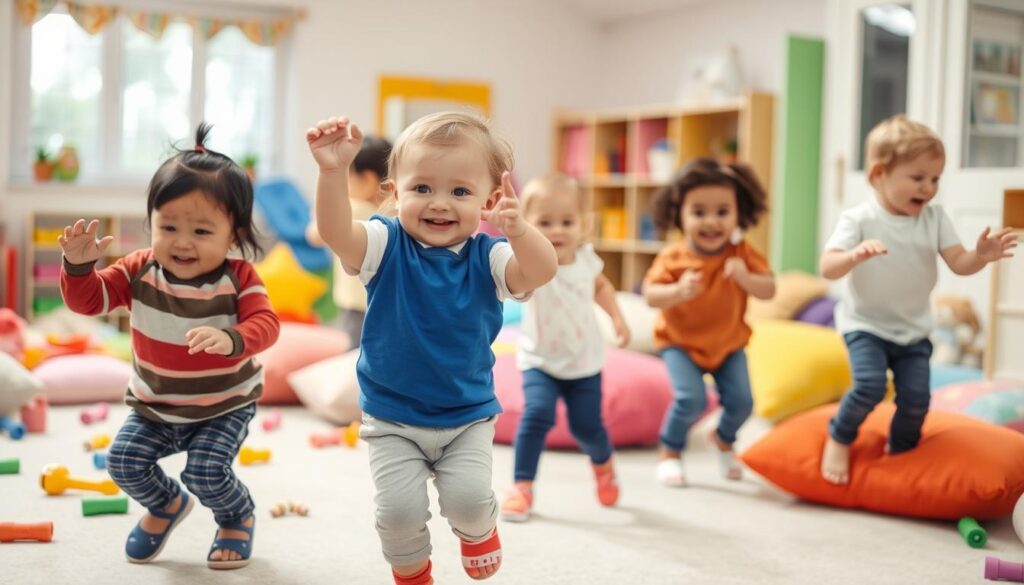
| Activity | Age Range | Benefits |
|---|---|---|
| Dance party | 1-3 years | Improves gross motor skills and coordination |
| Obstacle course | 2-4 years | Develops problem-solving skills and hand-eye coordination |
| Sensory bin activities | 1-3 years | Enhances sensory awareness and fine motor skills |
Building and Construction Play Ideas
Engaging in building and construction play is an excellent way to encourage toddlers to develop their fine motor skills and creativity. You can use blocks, building materials, and recycled materials to help children create unique and engaging structures. For example, you can use cardboard tubes and paper rolls to create a construction site, or use blocks to build a bridge.
Using recycled materials for building and construction play is not only fun but also environmentally friendly. You can collect various materials like cardboard, paper, and fabric to create a unique construction site. Remember to always supervise your child during playtime and encourage them to use their imagination. Some other ideas for recycled materials projects include creating a robot from an old cardboard box or making a bird feeder from a plastic bottle.
- Develops fine motor skills
- Encourages creativity and imagination
- Improves problem-solving skills
When engaging in building and construction play, it’s essential to follow safety guidelines to ensure your child’s well-being. Always supervise your child during playtime, and make sure they are using the materials safely and correctly.
| Material | Benefits |
|---|---|
| Blocks | Develops fine motor skills, encourages creativity and imagination |
| Recycled materials | Environmentally friendly, develops problem-solving skills |
Music and Dance Activities for Toddlers at Home
Engaging your toddler in music and dance activities is a great way to encourage physical activity, creativity, and self-expression. You can put on some fun music and have a dance party, or use simple instruments like maracas or tambourines to create a lively atmosphere. Singing songs and playing music games like the Melting Dance can also help your toddler develop their sense of rhythm and coordination.
Some benefits of music and dance activities for toddlers include improved gross motor skills, balance, and coordination. Dance activities can also help increase feelings of achievement, confidence, and self-esteem in children. By incorporating music and dance into your daily routine, you can provide your toddler with a fun and engaging way to learn and develop new skills.
Here are some ideas for music and dance activities you can try with your toddler:
- Put on some fun music and have a dance party
- Use simple instruments like maracas or tambourines to create a lively atmosphere
- Sing songs and play music games like the Melting Dance
- Encourage your toddler to explore different movements like marching, rolling, hopping, sliding, twirling, and tiptoeing
Remember to keep the activities simple and fun, and to always supervise your toddler during music and dance activities. With a little creativity, you can provide your toddler with a fun and engaging way to learn and develop new skills, and create lasting memories together.
Conclusion: Making Every Day Fun and Educational
As we’ve explored, making every day fun and educational for toddlers is essential for their overall development. By incorporating a variety of engaging activities into daily routines, parents and caregivers can nurture cognitive, physical, social, and emotional skills in these young, curious minds. From sensory play and creative art projects to kitchen science experiments and movement games, there are endless opportunities to transform ordinary moments into extraordinary learning experiences.
The key is to strike a balance between structured activities and unstructured play, allowing toddlers to explore, discover, and lead their own learning journeys. By fostering a love of learning early on, you can set the stage for a lifetime of curiosity, problem-solving, and personal growth. Remember, every day is a chance to make learning come alive through the power of imagination, creativity, and good old-fashioned fun!
FAQ
What are some fun activities for toddlers to do at home?
Some fun activities for toddlers at home include sensory bin adventures, creative art projects, kitchen science experiments, movement games, indoor exercise, building and construction play, and music and dance activities.
Why are indoor activities important for toddler development?
Indoor activities are vital for toddler development as they provide a safe and engaging environment for children to learn and grow. They help build critical skills through play, create quality time opportunities, and incorporate structured activities that support cognitive, physical, and social-emotional development.
How can I set up my home for toddler activities?
To set up your home for toddler activities, you need to focus on creating a toddler-friendly environment that encourages exploration and engagement while prioritizing safety. This includes following safety guidelines and implementing ideas to stimulate your child’s curiosity and learning.
What are some ideas for sensory bin adventures?
Sensory bin adventures can involve using safe materials like rice, beans, or sand to create themed sensory bins that encourage toddlers to explore their senses, particularly touch and feel. You can also provide clean-up tips and storage solutions to make the experience enjoyable and manageable.
What kind of creative art projects can I do with toddlers at home?
Simple creative art projects for toddlers at home can include using paper, markers, crayons, and other basic materials to encourage self-expression and develop fine motor skills.
What are some safe kitchen science experiments for toddlers?
Safe kitchen science experiments for toddlers can involve exploring safe kitchen chemistry, creating edible experiments, and learning through observation, all while fostering their curiosity and developing essential skills like problem-solving and critical thinking.
How can I incorporate movement games and indoor exercise into my toddler’s routine?
You can incorporate movement games and indoor exercise into your toddler’s routine by using simple materials like balls and balloons and creating a fun, engaging environment that encourages physical activity and gross motor development.
What are some building and construction play ideas for toddlers?
Building and construction play ideas for toddlers can involve using blocks, recycled materials, and other building materials to encourage fine motor skills, creativity, and problem-solving, while also following safety guidelines.
How can I incorporate music and dance activities into my toddler’s daily routine?
You can incorporate music and dance activities into your toddler’s daily routine by using simple instruments, singing songs, and having dance parties, which can help develop their creativity, rhythm, and coordination.
Why is it important to make every day fun and educational for toddlers?
Making every day fun and educational for toddlers is crucial for their development and can help create a strong foundation for future learning. By incorporating a variety of activities that support cognitive, physical, and social-emotional growth, you can encourage a love of learning and help your toddler thrive.

